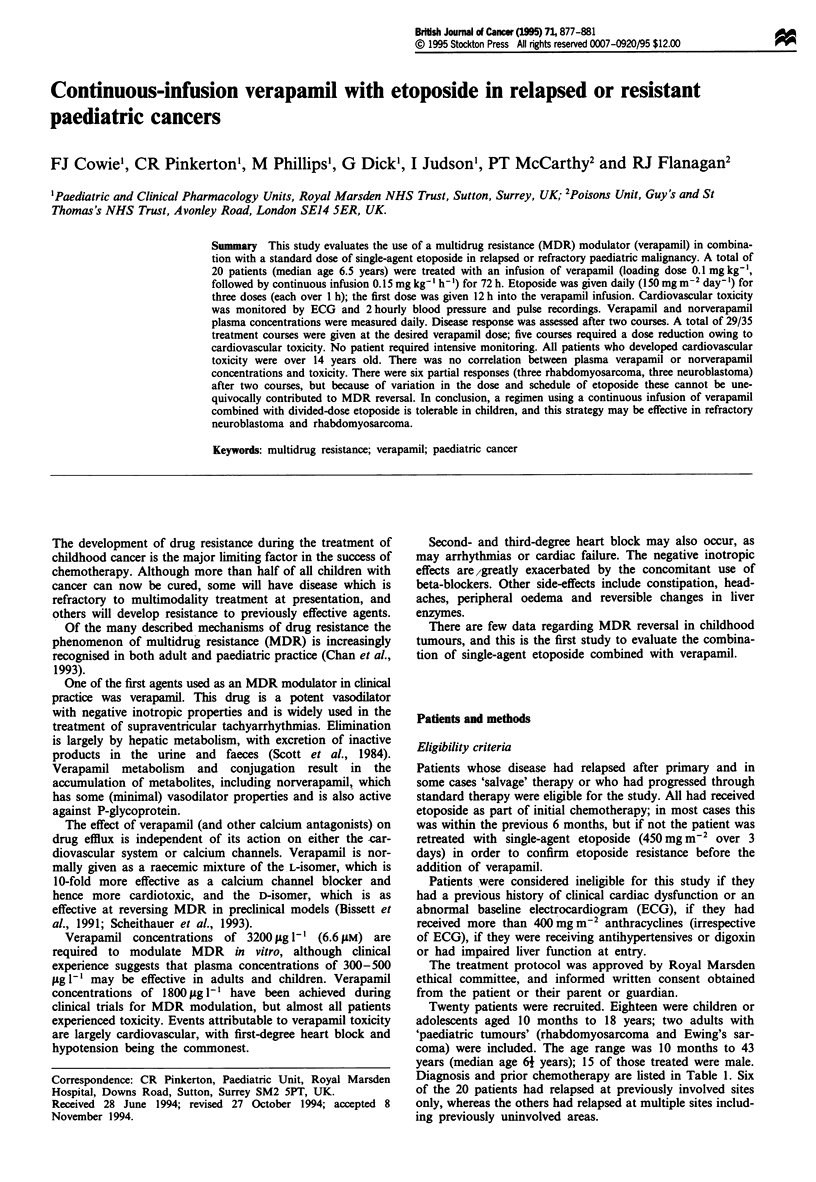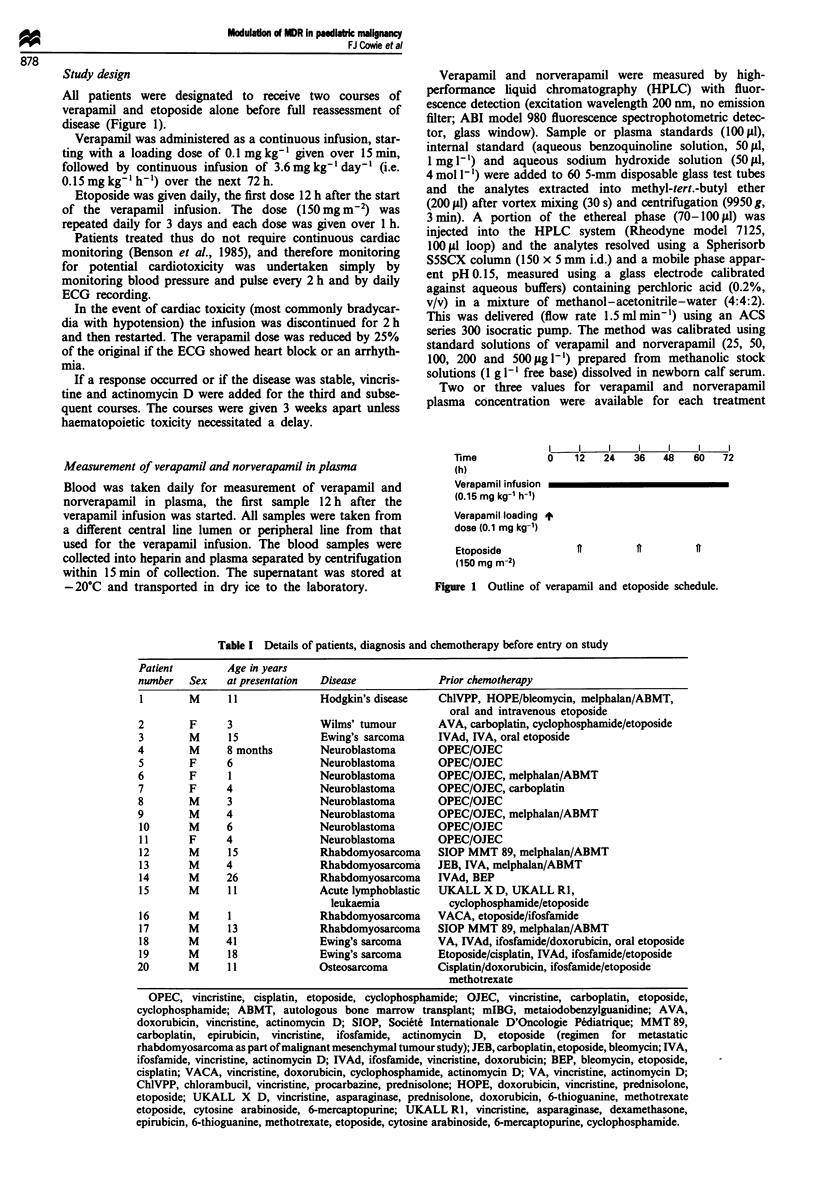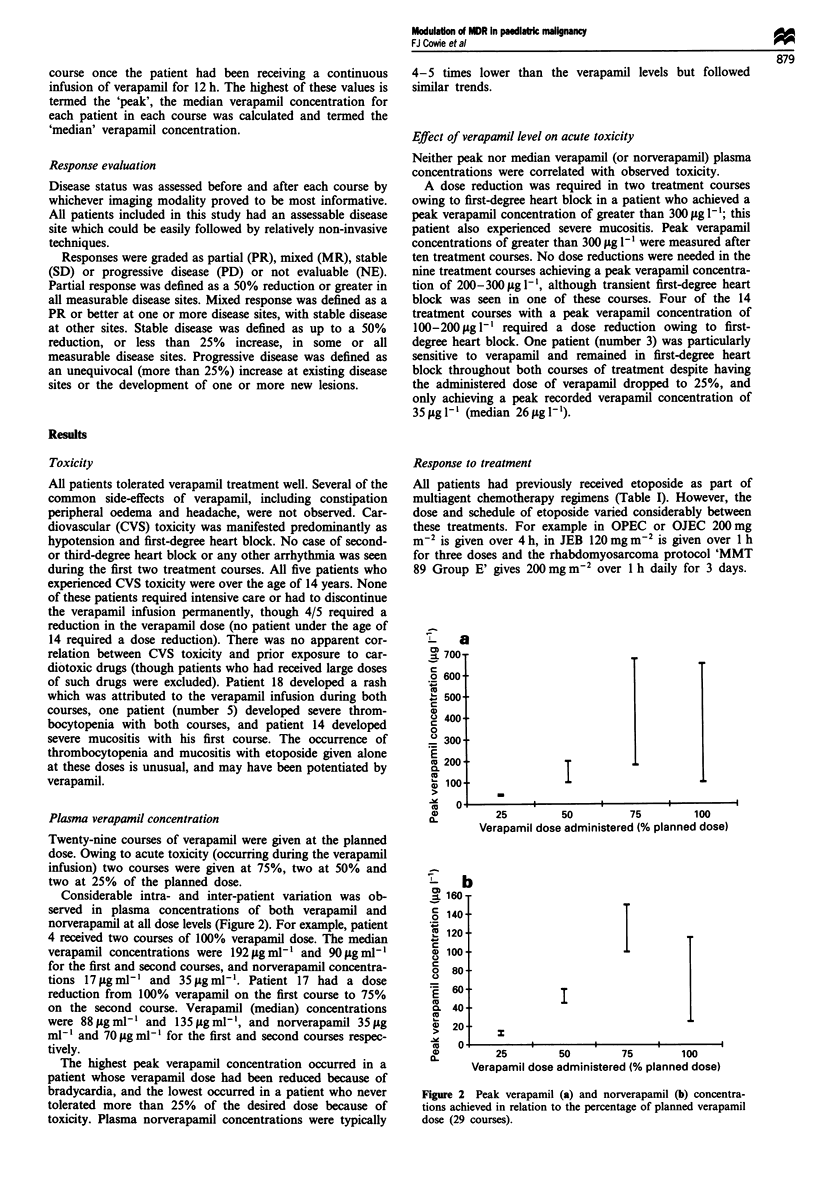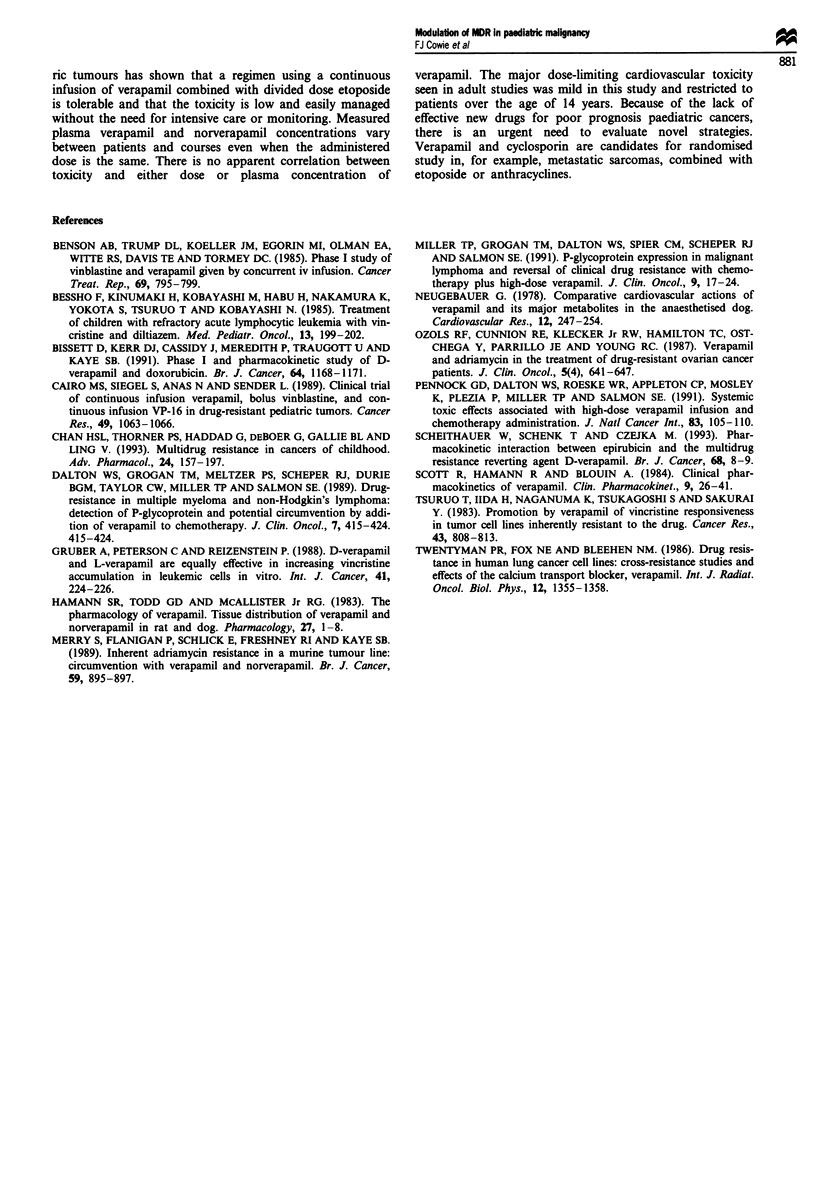Abstract
This study evaluates the use of a multidrug resistance (MDR) modulator (verapamil) in combination with a standard dose of single-agent etoposide in relapsed or refractory paediatric malignancy. A total of 20 patients (median age 6.5 years) were treated with an infusion of verapamil (loading dose 0.1 mg kg-1, followed by continuous infusion 0.15 mg kg-1 h-1) for 72 h. Etoposide was given daily (150 mg m-2 day-1) for three doses (each over 1 h); the first dose was given 12 h into the verapamil infusion. Cardiovascular toxicity was monitored by ECG and 2 hourly blood pressure and pulse recordings. Verapamil and norverapamil plasma concentrations were measured daily. Disease response was assessed after two courses. A total of 29/35 treatment courses were given at the desired verapamil dose; five courses required a dose reduction owing to cardiovascular toxicity. No patient required intensive monitoring. All patients who developed cardiovascular toxicity were over 14 years old. There was no correlation between plasma verapamil or norverapamil concentrations and toxicity. There were six partial responses (three rhabdomyosarcoma, three neuroblastoma) after two courses, but because of variation in the dose and schedule of etoposide these cannot be unequivocally contributed to MDR reversal. In conclusion, a regimen using a continuous infusion of verapamil combined with divided-dose etoposide is tolerable in children, and this strategy may be effective in refractory neuroblastoma and rhabdomyosarcoma.
Full text
PDF




Selected References
These references are in PubMed. This may not be the complete list of references from this article.
- Benson A. B., 3rd, Trump D. L., Koeller J. M., Egorin M. I., Olman E. A., Witte R. S., Davis T. E., Tormey D. C. Phase I study of vinblastine and verapamil given by concurrent iv infusion. Cancer Treat Rep. 1985 Jul-Aug;69(7-8):795–799. [PubMed] [Google Scholar]
- Bessho F., Kinumaki H., Kobayashi M., Habu H., Nakamura K., Yokota S., Tsuruo T., Kobayashi N. Treatment of children with refractory acute lymphocytic leukemia with vincristine and diltiazem. Med Pediatr Oncol. 1985;13(4):199–202. doi: 10.1002/mpo.2950130408. [DOI] [PubMed] [Google Scholar]
- Bissett D., Kerr D. J., Cassidy J., Meredith P., Traugott U., Kaye S. B. Phase I and pharmacokinetic study of D-verapamil and doxorubicin. Br J Cancer. 1991 Dec;64(6):1168–1171. doi: 10.1038/bjc.1991.484. [DOI] [PMC free article] [PubMed] [Google Scholar]
- Cairo M. S., Siegel S., Anas N., Sender L. Clinical trial of continuous infusion verapamil, bolus vinblastine, and continuous infusion VP-16 in drug-resistant pediatric tumors. Cancer Res. 1989 Feb 15;49(4):1063–1066. [PubMed] [Google Scholar]
- Chan H. S., Thorner P. S., Haddad G., DeBoer G., Gallie B. L., Ling V. Multidrug resistance in cancers of childhood: clinical relevance and circumvention. Adv Pharmacol. 1993;24:157–197. doi: 10.1016/s1054-3589(08)60937-0. [DOI] [PubMed] [Google Scholar]
- Dalton W. S., Grogan T. M., Meltzer P. S., Scheper R. J., Durie B. G., Taylor C. W., Miller T. P., Salmon S. E. Drug-resistance in multiple myeloma and non-Hodgkin's lymphoma: detection of P-glycoprotein and potential circumvention by addition of verapamil to chemotherapy. J Clin Oncol. 1989 Apr;7(4):415–424. doi: 10.1200/JCO.1989.7.4.415. [DOI] [PubMed] [Google Scholar]
- Gruber A., Peterson C., Reizenstein P. D-verapamil and L-verapamil are equally effective in increasing vincristine accumulation in leukemic cells in vitro. Int J Cancer. 1988 Feb 15;41(2):224–226. doi: 10.1002/ijc.2910410211. [DOI] [PubMed] [Google Scholar]
- Hamann S. R., Blouin R. A., McAllister R. G., Jr Clinical pharmacokinetics of verapamil. Clin Pharmacokinet. 1984 Jan-Feb;9(1):26–41. doi: 10.2165/00003088-198409010-00002. [DOI] [PubMed] [Google Scholar]
- Merry S., Flanigan P., Schlick E., Freshney R. I., Kaye S. B. Inherent adriamycin resistance in a murine tumour line: circumvention with verapamil and norverapamil. Br J Cancer. 1989 Jun;59(6):895–897. doi: 10.1038/bjc.1989.189. [DOI] [PMC free article] [PubMed] [Google Scholar]
- Miller T. P., Grogan T. M., Dalton W. S., Spier C. M., Scheper R. J., Salmon S. E. P-glycoprotein expression in malignant lymphoma and reversal of clinical drug resistance with chemotherapy plus high-dose verapamil. J Clin Oncol. 1991 Jan;9(1):17–24. doi: 10.1200/JCO.1991.9.1.17. [DOI] [PubMed] [Google Scholar]
- Neugebauer G. Comparative cardiovascular actions of verapamil and its major metabolites in the anaesthetised dog. Cardiovasc Res. 1978 Apr;12(4):247–254. doi: 10.1093/cvr/12.4.247. [DOI] [PubMed] [Google Scholar]
- Ozols R. F., Cunnion R. E., Klecker R. W., Jr, Hamilton T. C., Ostchega Y., Parrillo J. E., Young R. C. Verapamil and adriamycin in the treatment of drug-resistant ovarian cancer patients. J Clin Oncol. 1987 Apr;5(4):641–647. doi: 10.1200/JCO.1987.5.4.641. [DOI] [PubMed] [Google Scholar]
- Pennock G. D., Dalton W. S., Roeske W. R., Appleton C. P., Mosley K., Plezia P., Miller T. P., Salmon S. E. Systemic toxic effects associated with high-dose verapamil infusion and chemotherapy administration. J Natl Cancer Inst. 1991 Jan 16;83(2):105–110. doi: 10.1093/jnci/83.2.105. [DOI] [PubMed] [Google Scholar]
- Tsuruo T., Iida H., Naganuma K., Tsukagoshi S., Sakurai Y. Promotion by verapamil of vincristine responsiveness in tumor cell lines inherently resistant to the drug. Cancer Res. 1983 Feb;43(2):808–813. [PubMed] [Google Scholar]
- Twentyman P. R., Fox N. E., Bleehen N. M. Drug resistance in human lung cancer cell lines: cross-resistance studies and effects of the calcium transport blocker, verapamil. Int J Radiat Oncol Biol Phys. 1986 Aug;12(8):1355–1358. doi: 10.1016/0360-3016(86)90170-7. [DOI] [PubMed] [Google Scholar]


